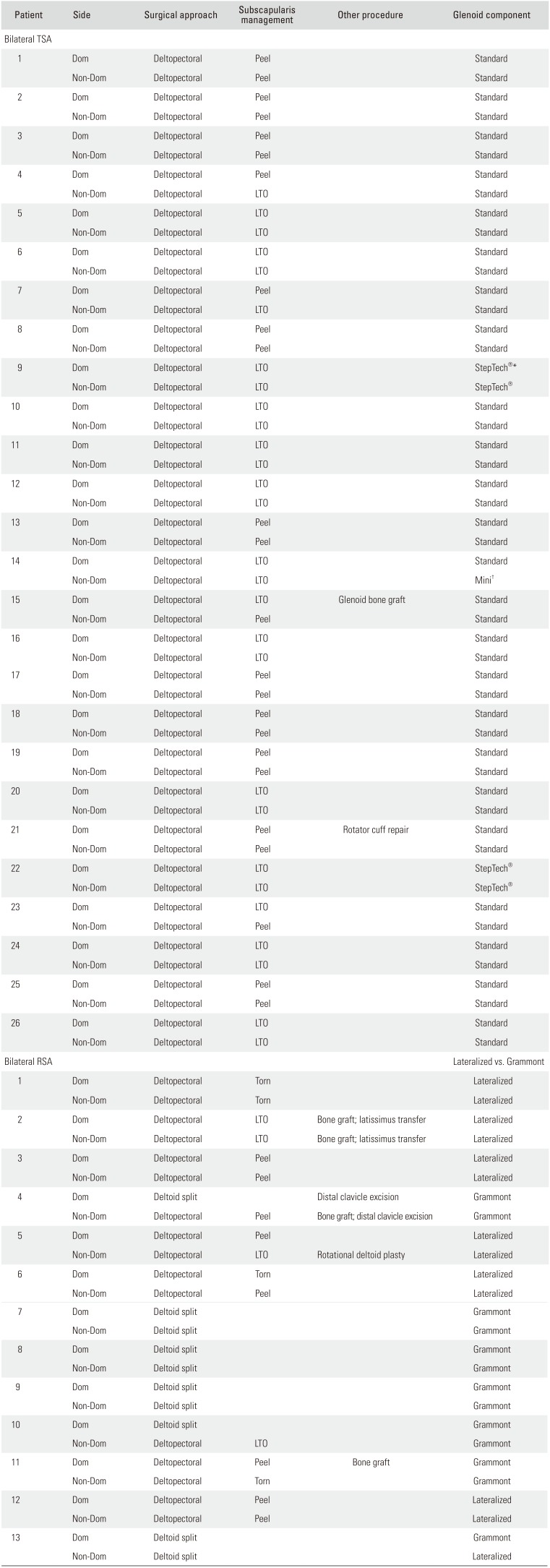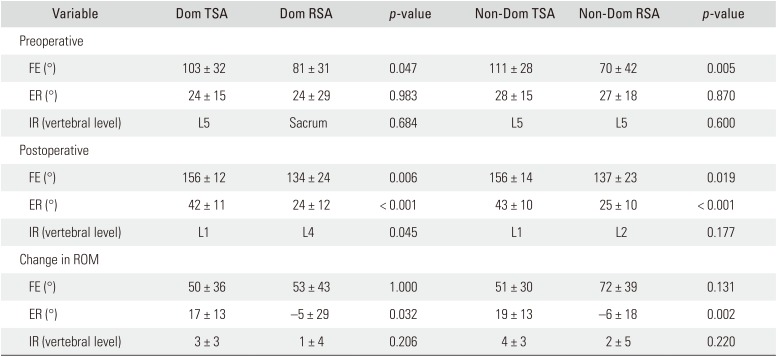1. Cil A, Veillette CJ, Sanchez-Sotelo J, Sperling JW, Schleck CD, Cofield RH. Survivorship of the humeral component in shoulder arthroplasty. J Shoulder Elbow Surg. 2010; 19(1):143–150. PMID:
19556148.

2. Deshmukh AV, Koris M, Zurakowski D, Thornhill TS. Total shoulder arthroplasty: long-term survivorship, functional outcome, and quality of life. J Shoulder Elbow Surg. 2005; 14(5):471–479. PMID:
16194737.

3. Khan A, Bunker TD, Kitson JB. Clinical and radiological follow-up of the Aequalis third-generation cemented total shoulder replacement: a minimum ten-year study. J Bone Joint Surg Br. 2009; 91(12):1594–1600. PMID:
19949123.
4. Raiss P, Bruckner T, Rickert M, Walch G. Longitudinal observational study of total shoulder replacements with cement: fifteen to twenty-year follow-up. J Bone Joint Surg Am. 2014; 96(3):198–205. PMID:
24500581.
5. Raiss P, Schmitt M, Bruckner T, et al. Results of cemented total shoulder replacement with a minimum follow-up of ten years. J Bone Joint Surg Am. 2012; 94(23):e1711–e1710. PMID:
23224391.

6. Schoch B, Schleck C, Cofield RH, Sperling JW. Shoulder arthroplasty in patients younger than 50 years: minimum 20-year follow-up. J Shoulder Elbow Surg. 2015; 24(5):705–710. PMID:
25306496.
7. Boileau P, Watkinson DJ, Hatzidakis AM, Balg F. Grammont reverse prosthesis: design, rationale, and biomechanics. J Shoulder Elbow Surg. 2005; 14(1 Suppl S):147S–161S. PMID:
15726075.

8. Padegimas EM, Maltenfort M, Lazarus MD, Ramsey ML, Williams GR, Namdari S. Future patient demand for shoulder arthroplasty by younger patients: national projections. Clin Orthop Relat Res. 2015; 473(6):1860–1867. PMID:
25758376.

9. Boileau P, Watkinson D, Hatzidakis AM, Hovorka I. Neer Award 2005: The Grammont reverse shoulder prosthesis: results in cuff tear arthritis, fracture sequelae, and revision arthroplasty. J Shoulder Elbow Surg. 2006; 15(5):527–540. PMID:
16979046.

10. Smith CD, Guyver P, Bunker TD. Indications for reverse shoulder replacement: a systematic review. J Bone Joint Surg Br. 2012; 94(5):577–583. PMID:
22529074.
11. Levy O, Walecka J, Arealis G, et al. Bilateral reverse total shoulder arthroplasty-functional outcome and activities of daily living. J Shoulder Elbow Surg. 2017; 26(4):e85–e96. PMID:
27856265.

12. Mellano CR, Kupfer N, Thorsness R, et al. Functional results of bilateral reverse total shoulder arthroplasty. J Shoulder Elbow Surg. 2017; 26(6):990–996. PMID:
28094191.

13. Stevens CG, Struk AM, Wright TW. The functional impact of bilateral reverse total shoulder arthroplasty. J Shoulder Elbow Surg. 2014; 23(9):1341–1348. PMID:
24581874.

14. Wirth B, Kolling C, Schwyzer HK, Flury M, Audige L. Risk of insufficient internal rotation after bilateral reverse shoulder arthroplasty: clinical and patient-reported outcome in 57 patients. J Shoulder Elbow Surg. 2016; 25(7):1146–1154. PMID:
26810018.

15. Fabricant PD, Chin CS, Grawe BM, Dines JS, Craig EV, Dines DM. Staged bilateral total shoulder arthroplasty: improved outcomes with less than 6 months between surgeries. J Shoulder Elbow Surg. 2016; 25(11):1774–1779. PMID:
27288274.

16. Gerber C, Lingenfelter EJ, Reischl N, Sukthankar A. Single-stage bilateral total shoulder arthroplasty: a preliminary study. J Bone Joint Surg Br. 2006; 88(6):751–755. PMID:
16720768.
17. Gruson KI, Pillai G, Vanadurongwan B, Parsons BO, Flatow EL. Early clinical results following staged bilateral primary total shoulder arthroplasty. J Shoulder Elbow Surg. 2010; 19(1):137–142. PMID:
19525131.

18. Morris BJ, Haigler RE, O'Connor DP, Elkousy HA, Gartsman GM, Edwards TB. Outcomes of staged bilateral reverse shoulder arthroplasties for rotator cuff tear arthropathy. J Shoulder Elbow Surg. 2015; 24(3):474–481. PMID:
25441561.

19. Wiater BP, Boone CR, Koueiter DM, Wiater JM. Early outcomes of staged bilateral reverse total shoulder arthroplasty: a case-control study. Bone Joint J. 2013; 95(9):1232–1238. PMID:
23997138.
20. Samilson RL, Prieto V. Dislocation arthropathy of the shoulder. J Bone Joint Surg Am. 1983; 65(4):456–460. PMID:
6833319.

21. Hamada K, Yamanaka K, Uchiyama Y, Mikasa T, Mikasa M. A radiographic classification of massive rotator cuff tear arthritis. Clin Orthop Relat Res. 2011; 469(9):2452–2460. PMID:
21503787.

22. Bodian CA, Freedman G, Hossain S, Eisenkraft JB, Beilin Y. The visual analog scale for pain: clinical significance in postoperative patients. Anesthesiology. 2001; 95(6):1356–1361. PMID:
11748392.
23. Boileau P, Chuinard C, Roussanne Y, Bicknell RT, Rochet N, Trojani C. Reverse shoulder arthroplasty combined with a modified latissimus dorsi and teres major tendon transfer for shoulder pseudoparalysis associated with dropping arm. Clin Orthop Relat Res. 2008; 466(3):584–593. PMID:
18219547.

24. Michener LA, McClure PW, Sennett BJ. American Shoulder and Elbow Surgeons Standardized Shoulder Assessment Form, patient self-report section: reliability, validity, and responsiveness. J Shoulder Elbow Surg. 2002; 11(6):587–594. PMID:
12469084.

25. Williams GN, Gangel TJ, Arciero RA, Uhorchak JM, Taylor DC. Comparison of the Single Assessment Numeric Evaluation method and two shoulder rating scales: outcomes measures after shoulder surgery. Am J Sports Med. 1999; 27(2):214–221. PMID:
10102104.
26. Zlotolow DA, Catalano LW 3rd, Barron OA, Glickel SZ. Surgical exposures of the humerus. J Am Acad Orthop Surg. 2006; 14(13):754–765. PMID:
17148623.









 PDF
PDF ePub
ePub Citation
Citation Print
Print


 XML Download
XML Download